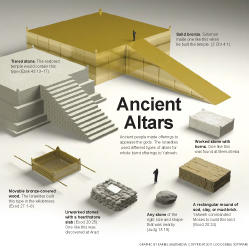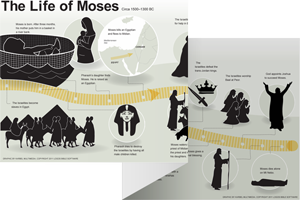24:1–18 Chapter 24 acts as a bridge between the giving of the covenant |
24:1 Nadab and Abihu The older two sons of Aaron who were later killed for offering incense improperly. See note on Lev 10:1. See Exod 6:23; Lev 10:1–3.
seventy Seventy is one of several numbers that is attributed a particular significance in the OT. For example, seventy is the number of nations Yahweh disowned at Babel and put under the authority of lesser gods (Gen 11:1–9; Deut 32:8–9; compare Deut 4:19–20). It is also the number of Jacob’s descendants who sojourned to Egypt during famine, before they became numerous and were enslaved (Exod 1:5). These 70 elders represent the fullness of what is referred to in the Hebrew text as Yahweh’s portion—His people (compare Deut 32:9)—suggesting that Israel was intended to bring the nations and Hebrew people back under Yahweh’s dominion as a kingdom of priests (Exod 19:6). Compare 3:16 and note; 3:18; 4:29.
and put under the authority of lesser gods (Gen 11:1–9; Deut 32:8–9; compare Deut 4:19–20). It is also the number of Jacob’s descendants who sojourned to Egypt during famine, before they became numerous and were enslaved (Exod 1:5). These 70 elders represent the fullness of what is referred to in the Hebrew text as Yahweh’s portion—His people (compare Deut 32:9)—suggesting that Israel was intended to bring the nations and Hebrew people back under Yahweh’s dominion as a kingdom of priests (Exod 19:6). Compare 3:16 and note; 3:18; 4:29.
24:2 Moses alone Moses’ relationship with Yahweh is marked by an access to the divine presence that is unequalled in all Israel’s history. Moses alone is able to approach the glory of Yahweh on a regular basis, whether on Mount Sinai (19:16–24; 24:2, 15–18), in the tent of meeting (33:7–11), or in the tabernacle (25:22; 30:6, 36; Num 7:89; 17:19).
24:3 we will do The people collectively and voluntarily enter into the Sinai covenant with Yahweh (compare Exod 19:8). Covenant is one of the major theological concepts of the ot—the term appears over 80 times in the Pentateuch. A covenant is an agreement or contract between two or more parties. Here, the two parties are God and Israel.
with Yahweh (compare Exod 19:8). Covenant is one of the major theological concepts of the ot—the term appears over 80 times in the Pentateuch. A covenant is an agreement or contract between two or more parties. Here, the two parties are God and Israel.
24:4 the words of Yahweh Likely refers to the instructions in Exod 20–23. Yahweh will give another set of tablets to Moses shortly (v. 12).
he built an altar Exodus 20:24–26 provided the rules for building such altars.
 Altars in the Old Testament Table
Altars in the Old Testament Table
twelve memorial stones In the patriarchal stories, pillars were erected to commemorate divine encounters (Gen 28:18, 22; 31:45; compare Exod 23:24 and note). Twelve pillars here signifies a divine encounter between Yahweh and all Israel—each of the 12 tribes.
24:5 burnt offerings The most common sacrifice in Israelite worship (see Lev 1:3–17 and note). Israelites made burnt offerings for atonement or thanksgiving.
sacrifices as fellowship offerings These offerings are brought for a variety of reasons depending on the purpose or occasion: thank offerings, free-will offerings, and votive offerings (see Lev 3:1–17 and note; compare Lev 7:11–18).
24:6 half of the blood The other half was used for sprinkling the people (Exod 24:8). Because blood is essential to life, it ultimately belongs to the life-giver, God (Gen 9:5–6).
is essential to life, it ultimately belongs to the life-giver, God (Gen 9:5–6).
24:7 the scroll of the covenant Refers to what Moses wrote in Exod 24:4. This phrase is generally considered the biblical name for the law code in chs. 20–23 (also called the Covenant Code; see note on 20:22–26).
see note on 20:22–26).
24:8 sprinkled it on the people The blood sprinkled on the altar and upon the people indicated that Yahweh and the people of Israel were bound together in the covenant. Other examples from the ancient Near East suggest that blood sacrifice was part of sealing a covenant because it bound one’s fate to the fate of the sacrificial animal. The implied, and sometimes audibly recited, statement was “may I be like this animal if I do not hold up my end of the agreement.”
24:10 under his feet Yahweh is described anthropomorphically—that is, with human features. On the nature of Moses’ earthly encounters with Yahweh, see note on 33:20.
sapphire tile work This description of Sinai as a magnificent throne room is virtually identical to descriptions of the palace of Baal—a leading Canaanite deity—in Canaanite literature. Since Baal was the storm-god, associated with a mountain top (Mount Zaphon), it is likely that this description was designed with this common motif in mind. Similar descriptions of Yahweh’s throne room are also found in Ezek 1 and Rev 4.
 Cosmic Garden and Mountain Imagery in the Old Testament
Cosmic Garden and Mountain Imagery in the Old Testament
like the very heavens Looking up to the heavens, where the deity resides, one might imagine the sky as the floor of the deity’s throne-room, clear and blue, as described here. This emphasizes the expansiveness of the deity’s domain, as well as the distance between divine and human realms.
24:11 he did not stretch out his hand An idiom for causing harm. The fact that Yahweh refrained from harming the elders is mentioned here because of previous warnings against getting too close to the divine presence, lest one be destroyed (e.g., Exod 19:10–24).
they beheld God All the participants—not just Moses—see Yahweh in visible form. Ultimately, this is a unique event, which no one should attempt to emulate (33:17–34:9).
24:12 Come up to me on the mountain God instructs Moses to come closer—further up the mountain—for more intimate access.
law and the commandments Presumably the Ten Commandments (20:1–21; 34:28).
I have written God writes the commandments on the tablets (compare 31:18; 32:16). Moses also wrote down the commandments of Yahweh (v. 4). Moses will later break these divinely inscribed tablets upon seeing the golden calf (32:15–19) and will write the replacement tablets himself (34:1–4, 28–29). These passages link the writing of the laws to both God and Moses. The issue is further complicated by the nt’s assertion that angels dispensed the law at Sinai (Gal 3:19; Acts 7:38, 53; Heb 2:2).
on the tablets (compare 31:18; 32:16). Moses also wrote down the commandments of Yahweh (v. 4). Moses will later break these divinely inscribed tablets upon seeing the golden calf (32:15–19) and will write the replacement tablets himself (34:1–4, 28–29). These passages link the writing of the laws to both God and Moses. The issue is further complicated by the nt’s assertion that angels dispensed the law at Sinai (Gal 3:19; Acts 7:38, 53; Heb 2:2).
24:13–15 This is one of the few insights Exodus provides about the leadership hierarchy of Israel during this period. Joshua is Moses’ assistant, and in the absence of both of them, Moses’ brother Aaron and Hur are in command. Hur is mentioned only twice: here and in the battle against Amalek (Exod 17:10). |
24:16 the glory of Yahweh Refers to the visible presence of Yahweh. See note on 16:10. Moses’ request to see God’s glory in 33:18 appears to have been a request for an even greater exposure to the very presence of God (see 33:18–23).
settled on Mount Sinai The glory of Yahweh appeared to the Israelites as a fiery cloud on the mountain.Moses Yahweh calls only Moses, who had climbed higher into the mountain (25:15); after six days, the other Israelite leaders have likely returned to camp.
from the midst of the cloud Meaning that God resides in the center of the cloud. The cloud is designed as a buffer between the divine presence and human beings, as it obscures direct viewing. Incense offerings in the tabernacle and temple will later serves this same purpose.
24:17 the eyes of the Israelites The people are below, at the foot of the mountain (19:10–24; 24:2). While they must maintain a certain distance, it is also important that they see the cloud indicating the presence of God, so that they may hear the divine word and believe Moses (19:9).
24:18 Moses went into the midst of the cloud The text does not indicate whether Moses sees anything other than the form he already witnessed in vv. 9–11. He may have entered into the cloud for the purpose of greater privacy, or to distinguish himself and his authority from the other Israelite leaders. See note on v. 2.
forty days and forty nights The number 40 appears frequently in the ot and is symbolic as a period of separation for the sake of spiritual purification and growth (see 34:28; Deut 9:9–18; 10:10; compare Matt 4). It is often used in scenes relevant to the cleansing of sin or spiritual impurity (Gen 7:4, 12, 17; 8:6; 50:3; Num 13:25; 14:33; Josh 5:6; 1 Kgs 19:8; Ezek 4:6; 29:11–13; Psa 95:10).

|
About Faithlife Study BibleFaithlife Study Bible (FSB) is your guide to the ancient world of the Old and New Testaments, with study notes and articles that draw from a wide range of academic research. FSB helps you learn how to think about interpretation methods and issues so that you can gain a deeper understanding of the text. |
| Copyright |
Copyright 2012 Logos Bible Software. |
| Support Info | fsb |
 Loading…
Loading…


